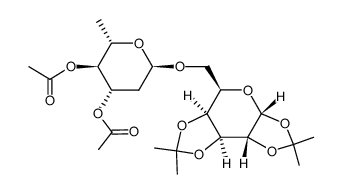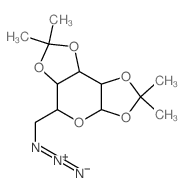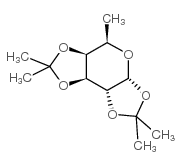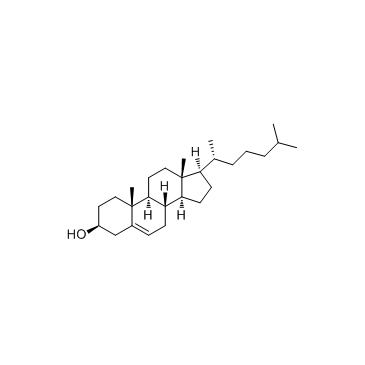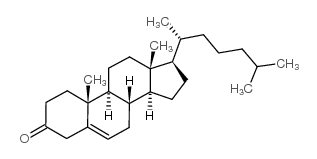4064-06-6
| 中文名 | 双丙酮半乳糖 |
|---|---|
| 英文名 | 1,2:3,4-Di-O-isopropylidene-D-galactopyranose |
| 中文别名 |
1,2:3,4-二-O-异亚丙基-D-吡喃半乳糖
1,2:3,4-二-O-异亚丙基-α-D-吡喃半乳糖 1,2:3,4-氧-异亚丙基-α-D-呋喃半乳糖 双丙酮-D-半乳糖 二丙酮-D-半乳糖 1,2:3,4-氧-异丙叉基-α-D-呋喃半乳糖 |
| 英文别名 |
1,2:3,4-Di-O-isopropylidene-α-D-galactopyranose
DIACETONE-D-GALACTOSE Diisopropylidenegalactopyranose (3aR,5R,5aS,8aS,8bR)-2,2,7,7-tetramethylperhydrodi[1,3]dioxolo[4,5-b:4,5-d]pyran-5-ylmethanol 1,2,3,4-di-O-Isopropylidenegalactopyranose 1,2:3,4-Di-O-isopropylidene-D-Galactopyranose Diisopropylidenegalactose Diisopropylidene Galactose 1,2:3,4-Di-O-isopropylidene-Alpha-D-galactopyranose 2,2,7,7-tetramethyl-(3aR,5R,5aS,8aS,8bR)-perhydrodi-1,3-dioxolo[4,5-b:4',5'-d]pyran-5-yl methanol 1,2,3,4-DI-O-ISOPROPYLIDENE-D-GALACTOPYRANOSE EINECS 223-771-7 1,2:3,4-Di-O-isopropylidene-a-D-galactopyranose (2,2,7,7-tetramethyltetrahydro-3aH-bis[1,3]dioxolo[4,5-b:4',5'-d]pyran-5-yl)methanol diisopropylidene-Gal-OH MFCD00063225 1,2:3,4-Di-O-isopropylidene-D-galactose 1,2:3,4-Di-O-isoprop [(3aR,5aS,8aS,8bR)-2,2,7,7-Tetramethyltetrahydro-3aH-bis[1,3]dioxolo[4,5-b:4',5'-d]pyran-5-yl]methanol [(3aR,5R,5aS,8aS,8bR)-2,2,7,7-Tetramethyltetrahydro-3aH-bis[1,3]dioxolo[4,5-b:4',5'-d]pyran-5-yl]methanol (2,2,7,7-tetramethyltetrahydrobis[1,3]dioxolo[5,4-b:4',5'-d]pyran-5-yl)methanol |
| 密度 | 1.2±0.1 g/cm3 |
|---|---|
| 沸点 | 366.8±0.0 °C at 760 mmHg |
| 熔点 | 120-122 °C |
| 分子式 | C12H20O6 |
| 分子量 | 260.284 |
| 闪点 | 159.3±26.5 °C |
| 精确质量 | 260.125977 |
| PSA | 66.38000 |
| LogP | 2.91 |
| 外观性状 | 透明无色透明液体 |
| 蒸汽压 | 0.0±1.8 mmHg at 25°C |
| 折射率 | 1.456 |
| 储存条件 | 避光,通风干燥处,密封保存 |
| 稳定性 | 常温常压下稳定 |
| 分子结构 | 1、 摩尔折射率:61.28 2、 摩尔体积(cm3/mol):225.5 3、 等张比容(90.2K):567.9 4、 表面张力(dyne/cm):40.2 5、 极化率(10-24cm3):24.29 |
Synonym:None Section 2 - COMPOSITION, INFORMATION ON INGREDIENTS
Risk Phrases: None Listed. Section 3 - HAZARDS IDENTIFICATION EMERGENCY OVERVIEW
The toxicological properties of this material have not been fully investigated. Potential Health Effects Eye: May cause eye irritation. Skin: May cause skin irritation. Ingestion: May cause irritation of the digestive tract. The toxicological properties of this substance have not been fully investigated. Inhalation: May cause respiratory tract irritation. The toxicological properties of this substance have not been fully investigated. Chronic: No information found. Section 4 - FIRST AID MEASURES Eyes: Immediately flush eyes with plenty of water for at least 15 minutes, occasionally lifting the upper and lower eyelids. Get medical aid. Skin: Get medical aid. Flush skin with plenty of water for at least 15 minutes while removing contaminated clothing and shoes. Wash clothing before reuse. Ingestion: Never give anything by mouth to an unconscious person. Get medical aid. Do NOT induce vomiting. If conscious and alert, rinse mouth and drink 2-4 cupfuls of milk or water. Inhalation: Remove from exposure and move to fresh air immediately. If not breathing, give artificial respiration. If breathing is difficult, give oxygen. Get medical aid. Notes to Physician: Section 5 - FIRE FIGHTING MEASURES General Information: As in any fire, wear a self-contained breathing apparatus in pressure-demand, MSHA/NIOSH (approved or equivalent), and full protective gear. During a fire, irritating and highly toxic gases may be generated by thermal decomposition or combustion. Vapors may be heavier than air. They can spread along the ground and collect in low or confined areas. Extinguishing Media: Use agent most appropriate to extinguish fire. Use water spray, dry chemical, carbon dioxide, or appropriate foam. Section 6 - ACCIDENTAL RELEASE MEASURES General Information: Use proper personal protective equipment as indicated in Section 8. Spills/Leaks: Cover with sand, dry lime or soda ash and place in a closed container for disposal. Provide ventilation. Section 7 - HANDLING and STORAGE Handling: Wash thoroughly after handling. Remove contaminated clothing and wash before reuse. Use with adequate ventilation. Avoid contact with eyes, skin, and clothing. Keep container tightly closed. Avoid ingestion and inhalation. Storage: Store in a tightly closed container. Store in a cool, dry, well-ventilated area away from incompatible substances. Section 8 - EXPOSURE CONTROLS, PERSONAL PROTECTION Engineering Controls: Facilities storing or utilizing this material should be equipped with an eyewash facility and a safety shower. Use adequate ventilation to keep airborne concentrations low. Exposure Limits CAS# 4064-06-6: Personal Protective Equipment Eyes: Wear appropriate protective eyeglasses or chemical safety goggles as described by OSHA's eye and face protection regulations in 29 CFR 1910.133 or European Standard EN166. Skin: Wear appropriate protective gloves to prevent skin exposure. Clothing: Wear appropriate protective clothing to prevent skin exposure. Respirators: A respiratory protection program that meets OSHA's 29 CFR 1910.134 and ANSI Z88.2 requirements or European Standard EN 149 must be followed whenever workplace conditions warrant respirator use. Section 9 - PHYSICAL AND CHEMICAL PROPERTIES Physical State: Clear liquid Color: clear, colorless Odor: None reported. pH: Not available. Vapor Pressure: Not available. Viscosity: Not available. Boiling Point: 117 deg C @ .01mmHg Freezing/Melting Point: Not available. Autoignition Temperature: Not applicable. Flash Point: Not applicable. Explosion Limits, lower: Not available. Explosion Limits, upper: Not available. Decomposition Temperature: Not available. Solubility in water: Not available. Specific Gravity/Density: 1.1430g/cm3 Molecular Formula: C12H20O6 Molecular Weight: 260.28 Section 10 - STABILITY AND REACTIVITY Chemical Stability: Stable under normal temperatures and pressures. Conditions to Avoid: Incompatible materials, strong oxidants. Incompatibilities with Other Materials: Oxidizing agents. Hazardous Decomposition Products: Carbon monoxide, irritating and toxic fumes and gases, carbon dioxide. Hazardous Polymerization: Has not been reported. Section 11 - TOXICOLOGICAL INFORMATION RTECS#: CAS# 4064-06-6 unlisted. LD50/LC50: Not available. Carcinogenicity: 1,2:3,4-Di-O-isopropylidene-D-galactopyranose - Not listed by ACGIH, IARC, or NTP. Section 12 - ECOLOGICAL INFORMATION Section 13 - DISPOSAL CONSIDERATIONS Dispose of in a manner consistent with federal, state, and local regulations. Section 14 - TRANSPORT INFORMATION IATA Not regulated as a hazardous material. IMO Not regulated as a hazardous material. RID/ADR Not regulated as a hazardous material. Section 15 - REGULATORY INFORMATION European/International Regulations European Labeling in Accordance with EC Directives Hazard Symbols: Not available. Risk Phrases: Safety Phrases: S 24/25 Avoid contact with skin and eyes. WGK (Water Danger/Protection) CAS# 4064-06-6: No information available. Canada None of the chemicals in this product are listed on the DSL/NDSL list. CAS# 4064-06-6 is not listed on Canada's Ingredient Disclosure List. US FEDERAL TSCA CAS# 4064-06-6 is not listed on the TSCA inventory. It is for research and development use only. SECTION 16 - ADDITIONAL INFORMATION N/A |
|
生态学数据: 通常对水是不危害的,若无政府许可,勿将材料排入周围环境.
|
| 上游产品 10 | |
|---|---|
| 下游产品 8 | |
| 海关编码 | 2914400090 |
|---|---|
| 中文概述 | 2914400090 其他酮醇及酮醛。监管条件:无。增值税率:17.0%。退税率:9.0%。最惠国关税:5.5%。普通关税:30.0% |
| 申报要素 | 品名, 成分含量, 用途, 丙酮报明包装 |
| Summary | 2914400090 other ketone-alcohols and ketone-aldehydes。Supervision conditions:None。VAT:17.0%。Tax rebate rate:9.0%。MFN tariff:5.5%。General tariff:30.0% |


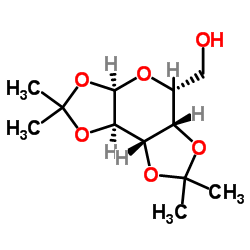

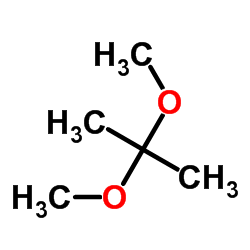
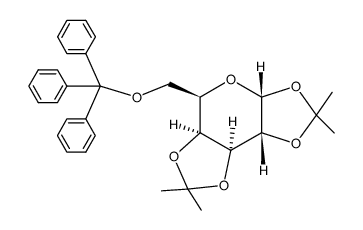
![tert-butyldimethyl(2,2,7,7-tetramethyltetrahydrobis[1,3]dioxolo[5,4-b:4',5'-d]pyran-5-ylmethoxy)silane结构式](https://image.chemsrc.com/caspic/082/108678-44-0.png)


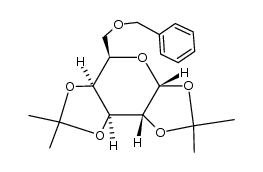
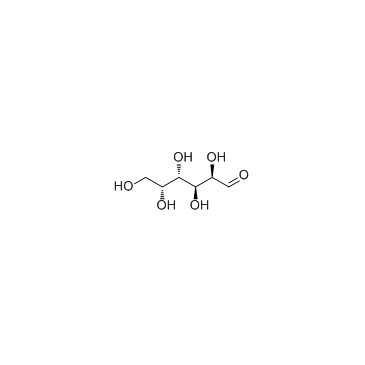
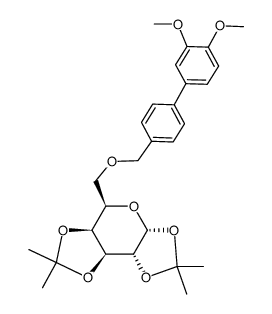
![(3aR,5R,5aS,8aS,8bR)-5-((benzhydryloxy)methyl)-2,2,7,7-tetramethyltetrahydro-5H-bis([1,3]dioxolo)[4,5-b:4',5'-d]pyran结构式](https://image.chemsrc.com/caspic/156/81712-60-9.png)
